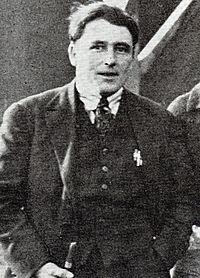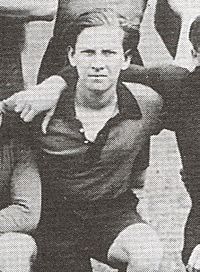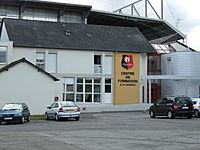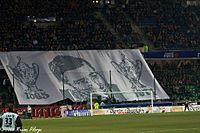Stade Rennais FC facts for kids
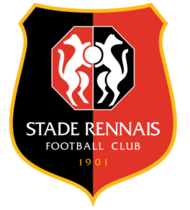 |
||
| Full name | Stade Rennais Football Club | |
|---|---|---|
| Nickname(s) | Les Rennais (The Rennais) Les Rouge et Noirs (The Red and Blacks) |
|
| Short name | SRFC, Rennes | |
| Founded | 10 March 1901 | |
| Ground | Roazhon Park | |
| Capacity | 29,778 | |
| Owner | Artémis | |
| President | Arnaud Pouille | |
| Manager | Habib Beye | |
| League | Ligue 1 | |
| 2021–22 | Ligue 1, 4th of 20 | |
|
|
||
Stade Rennais Football Club, often called Stade Rennais or just Rennes, is a professional football team from Rennes, Brittany, France. They play in Ligue 1, which is the top football league in France. Their home games are held at Roazhon Park.
The club was started in 1901 as Stade Rennais. It was one of the first teams to join France's top football division. Rennes has a big rivalry with Nantes, and their matches are known as the Derby Breton. Rennes has won the Coupe de France three times: in 1965, 1971, and 2019. Their best league finish was third place in the 2019–20 season.
Rennes is also famous for its youth academy, called the Henri Guérin Training Centre. It was created in 2000. In 2010, the French Football Federation (FFF) said it was the best youth academy in France. Many talented players have come from this academy, including Ousmane Dembélé and Eduardo Camavinga.
Contents
Club History
Stade Rennais Football Club was founded on March 10, 1901, by a group of former students in Brittany. Football was becoming popular in the area. The club played its first match two weeks later, losing 6–0 to FC Rennais.
In 1902, Stade Rennais joined the USFSA federation. They also helped create the Ligue de Bretagne de football, a new regional league. In their second season, they won the league by beating FC Rennais 4–0 in the final.
Merging and Early Success
On May 4, 1904, Stade Rennais joined with their rivals FC Rennais. They formed a new club called Stade Rennais Université Club. Their goal was to beat US Saint-Malo, who had been winning the Ligue de Bretagne. The new club wore red and black, which were Rennais' colors. Rennes finally beat Saint-Malo in 1908, led by Welsh manager Arthur Griffith. They won the league again the next year.
After World War I, Rennes focused on winning the new Coupe de France competition. They reached the final in 1922 but lost to Red Star Olympique.
In 1930, French football decided to allow professional players. Rennes, led by president Isidore Odorico, was one of the first clubs to become professional. They were also founding members of the new professional league. In 1935, Rennes reached the Coupe de France final again but lost 3–0 to Marseille.
Post-War Period and First Trophies
After World War II, Rennes returned to the top division. In the 1948–49 season, they had their best league finish, coming in fourth place. However, the club struggled to stay consistent in the 1950s, moving between the first and second divisions.
Under new president Louis Girard, Rennes improved a lot. They were promoted back to Division 1 in 1958. In the 1964–65 season, managed by former player Jean Prouff, Rennes finished fourth. In the same season, they won their first major trophy, the Coupe de France. They beat UA Sedan-Torcy 3–1 in a replay after the first match ended in a 2–2 draw. This win allowed Rennes to play in a European competition for the first time in the 1965–66 season.
Rennes won their second Coupe de France title in 1971. They beat Lyon 1–0 in the final. On May 23, 1972, the club officially changed its name to Stade Rennais Football Club.
Modern Era and Youth Academy Focus
From 1972 to 1994, Rennes had many different managers and often moved between the first and second divisions. In the 1980s, the city of Rennes took over most of the club's ownership.
In 1994, Rennes returned to Division 1 and became more stable. This was mainly because they started using their youth academy more. Instead of buying expensive players, Rennes trained its young players and brought them into the main team. Players like Sylvain Wiltord came from this strategy.
In 1998, businessman François Pinault bought the club. He invested a lot of money, building a new training center in 2000. He also rebuilt the stadium and bought new players.
From 2000 to 2010, Rennes played in European competitions five times. Their youth academy continued to produce many talented players. In the league, Rennes finished fourth in 2004–05 and again two seasons later. In 2009, Rennes reached the Coupe de France final but lost to their Breton rivals Guingamp 2–1. They lost to Guingamp again in the 2014 final.
In the 2017–18 season, Rennes finished 5th in Ligue 1, which qualified them for the UEFA Europa League. In the 2018–19 season, Rennes won their third Coupe de France title. They beat Paris Saint-Germain 6–5 on penalties after coming back from two goals down. They also had a great Europa League run, reaching the Round of 16. They beat Real Betis and then won the first leg against Arsenal 3–1 at home, but were eliminated after losing the second leg 3–0.
In the 2019–20 season, Rennes finished third in Ligue 1. This allowed them to play in the 2020–21 UEFA Champions League for the first time ever.
Home Stadium
Rennes has played at the location of their stadium, Roazhon Park, since 1912. The stadium was first called Stade de Route de Lorient. It was officially opened on September 15, 1912.
The city of Rennes owns Roazhon Park. It has been renovated three times: in 1955, 1983, and 1999. The latest renovations, finished in 2004, cost €37.3 million. The stadium can hold 29,778 spectators.
Training Center
The Henri-Guérin Training Center, also known as La Piverdière, opened in June 2000. It is named after former player and manager Henri Guérin. The center is located just outside Rennes. It is where the main team trains, along with the club's reserve and youth teams. Since 2007, the club's offices have also been at La Piverdière.
La Piverdière is well-known for producing many talented young players who have become famous internationally. Many players on the club's first team have come from this youth system. Rennes has been recognized as having the best youth academy in France.
Rennes has won the Coupe Gambardella, which is the national youth competition for under-19 teams, three times: in 1973, 2003, and 2008.
Supporters
Rennes has several supporter groups. The oldest and largest traditional group is Allez Rennes, founded in 1962.
The Tribune Mordelles section of the stadium is home to the Roazhon Celtic Kop (RCK). This group was formed in 1991. The RCK is known for its continuous singing, flares, and large displays called tifos. They often show off Breton (local region) identity and Celtic symbols. The RCK made the largest Gwenn-ha-du (Breton flag) ever, measuring 270 square meters.
The RCK supports the team at all matches, including European games. They believe in "Friendship, Respect, and Party." The group is against "football business" and racism. They are part of networks that fight racism in football.
Another supporter group, Section Roazhon Pariz, is based in Paris. They support the team at important away matches. In 2008, a new group called Unvez Kelt (UK) was founded, but it later dissolved in 2012. The main rival of the RCK has been the Brigade Loire, a supporter group of Nantes.
Players
Current Team
|
|
Players on Loan
|
|
Retired Jersey Numbers
The number 29 jersey has been retired by Stade Rennais to honor player Romain Danzé.
| No. | Player | Nationality | Position | Rennes debut | Last match |
|---|---|---|---|---|---|
| 29 | Romain Danzé | Right back | 4 November 2006 | 7 January 2018 |
Famous Players
Many well-known players have played for Rennes. Here are some of them:
 Ramy Bensebaini
Ramy Bensebaini Raïs M'Bolhi
Raïs M'Bolhi Jérémy Doku
Jérémy Doku Raphinha
Raphinha Petr Čech
Petr Čech Benjamin André
Benjamin André Jimmy Briand
Jimmy Briand Eduardo Camavinga
Eduardo Camavinga Romain Danzé
Romain Danzé Ousmane Dembélé
Ousmane Dembélé Yoann Gourcuff
Yoann Gourcuff Jocelyn Gourvennec
Jocelyn Gourvennec Steve Mandanda
Steve Mandanda Steven Nzonzi
Steven Nzonzi Mathys Tel
Mathys Tel Sylvain Wiltord
Sylvain Wiltord Asamoah Gyan
Asamoah Gyan Laurent Pokou
Laurent Pokou Abdoulaye Doucouré
Abdoulaye Doucouré Nayef Aguerd
Nayef Aguerd John Utaka
John Utaka Édouard Mendy
Édouard Mendy Ismaïla Sarr
Ismaïla Sarr Moussa Sow
Moussa Sow Nemanja Matić
Nemanja Matić Alexander Frei
Alexander Frei
Club Management and Coaching
Club Officials
| Position | Staff |
|---|---|
| President | Arnaud Pouille |
| Technical Director | Loic Desire |
| Manager | Habib Beye |
| Assistant manager | Olivier Saragaglia |
| Abel Pimenta | |
| Sébastien Bichard | |
| Goalkeeper coach | Olivier Sorin |
| Youth academy director | Denis Arnaud |
Coaching History
Here is a list of coaches who have managed Stade Rennais over the years:
|
Club Achievements
League Titles
- Ligue 2:
- Champions: 1955–56, 1982–83
Cup Wins
- Coupe de France:
- Winners: 1964–65, 1970–71, 2018–19
- Runners-up (Finalists): 1921–22, 1934–35, 2008–09, 2013–14
- Coupe de la Ligue:
- Runners-up (Finalists): 2012–13
- Trophée des Champions:
- Winners: 1971
- Runners-up (Finalists): 1965, 2019
European Competitions
- UEFA Intertoto Cup:
- Joint Winners: 2008
Youth Team Success
- Coupe Gambardella: (Under-19 national youth competition)
- Champions: 1973, 2003, 2008
Rennes in European Football
See also
 In Spanish: Stade Rennes Football Club para niños
In Spanish: Stade Rennes Football Club para niños



